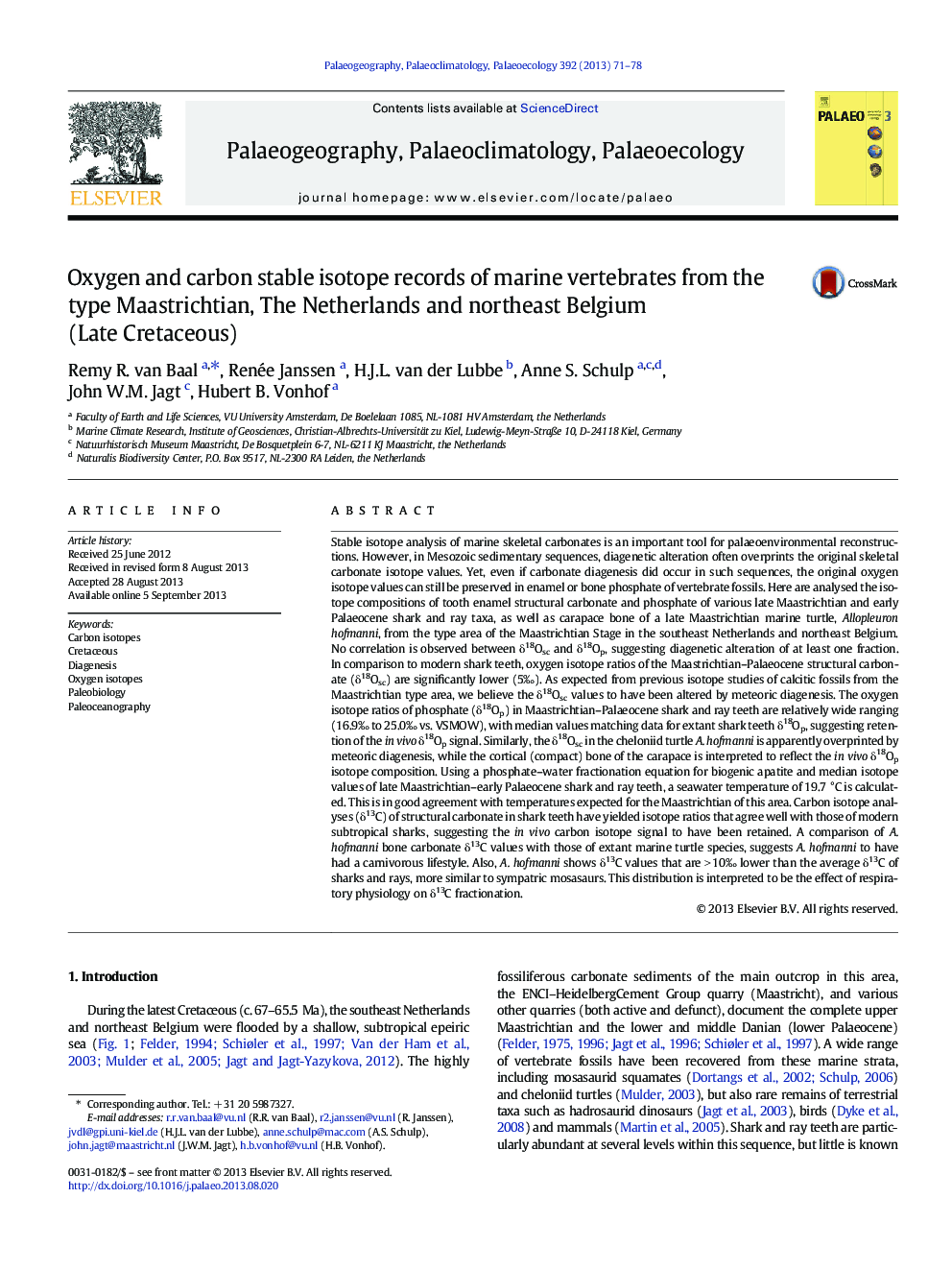| کد مقاله | کد نشریه | سال انتشار | مقاله انگلیسی | نسخه تمام متن |
|---|---|---|---|---|
| 4466429 | 1622198 | 2013 | 8 صفحه PDF | دانلود رایگان |

• Better diagenetic control on Type Maastrichtian stable isotope records
• Enhanced insight in the ecology of multiple Type Maastrichtian vertebrate species
• Improved palaeoceanographic reconstruction of the Type Maastrichtian
Stable isotope analysis of marine skeletal carbonates is an important tool for palaeoenvironmental reconstructions. However, in Mesozoic sedimentary sequences, diagenetic alteration often overprints the original skeletal carbonate isotope values. Yet, even if carbonate diagenesis did occur in such sequences, the original oxygen isotope values can still be preserved in enamel or bone phosphate of vertebrate fossils. Here are analysed the isotope compositions of tooth enamel structural carbonate and phosphate of various late Maastrichtian and early Palaeocene shark and ray taxa, as well as carapace bone of a late Maastrichtian marine turtle, Allopleuron hofmanni, from the type area of the Maastrichtian Stage in the southeast Netherlands and northeast Belgium. No correlation is observed between δ18Osc and δ18Op, suggesting diagenetic alteration of at least one fraction. In comparison to modern shark teeth, oxygen isotope ratios of the Maastrichtian–Palaeocene structural carbonate (δ18Osc) are significantly lower (5‰). As expected from previous isotope studies of calcitic fossils from the Maastrichtian type area, we believe the δ18Osc values to have been altered by meteoric diagenesis. The oxygen isotope ratios of phosphate (δ18Op) in Maastrichtian–Palaeocene shark and ray teeth are relatively wide ranging (16.9‰ to 25.0‰ vs. VSMOW), with median values matching data for extant shark teeth δ18Op, suggesting retention of the in vivo δ18Op signal. Similarly, the δ18Osc in the cheloniid turtle A. hofmanni is apparently overprinted by meteoric diagenesis, while the cortical (compact) bone of the carapace is interpreted to reflect the in vivo δ18Op isotope composition. Using a phosphate–water fractionation equation for biogenic apatite and median isotope values of late Maastrichtian–early Palaeocene shark and ray teeth, a seawater temperature of 19.7 °C is calculated. This is in good agreement with temperatures expected for the Maastrichtian of this area. Carbon isotope analyses (δ13C) of structural carbonate in shark teeth have yielded isotope ratios that agree well with those of modern subtropical sharks, suggesting the in vivo carbon isotope signal to have been retained. A comparison of A. hofmanni bone carbonate δ13C values with those of extant marine turtle species, suggests A. hofmanni to have had a carnivorous lifestyle. Also, A. hofmanni shows δ13C values that are > 10‰ lower than the average δ13C of sharks and rays, more similar to sympatric mosasaurs. This distribution is interpreted to be the effect of respiratory physiology on δ13C fractionation.
Journal: Palaeogeography, Palaeoclimatology, Palaeoecology - Volume 392, 15 December 2013, Pages 71–78